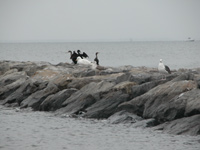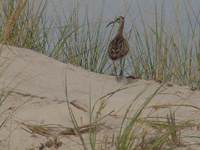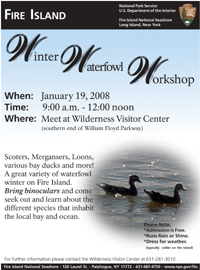 |
 | |
  | |
|
|
|
|
Fire Island National Seashore
Birdwatching
|
|
|
|
|
| |
 |
 |
| The Eastern Towhee is one of the summer resident birds that breeds on Fire Island. |
 |
Fire Island's barrier island habitats and location on the Atlantic Flyway make this a good home for both resident and migratory birds.
The tidal marsh on the Great South Bay, especially at , is a good place to look for waterfowl, herons and egrets, and red-winged blackbirds.
The Sunken Forest, a mature maritime forest at , provides dense cover for migrating warblers. Other birds, such as the towhee, can be heard rustling the leaves on the forest floor.
Near the Fire Island Lighthouse, the fall migration of hawks is monitored by the Fire Island Raptor Enumerators () from September through mid-November.
Varied habitats of the include woods and fields, creeks and salt marsh, providing additional opportunities for bird watching.
|
 |
| While the Double-crested Cormorant is seen on the Great South Bay from spring through fall, the Great Black-backed Gull is abundant all year long. |
 |
Local Audubon Society groups participate in "citizen science" by conducting annual Christmas Bird Count censuses and the Summer Breeding Bird Census in parts of the park.
The and sponsor an annual Great Backyard Bird Count in February. Participants can log on and get the easy-to-follow instructions and checklists needed to submit a report from their own backyard or local park or refuge. If Fire Island National Seashore is a part of your "backyard," join the count and provide your observations.
- Great Backyard Bird Count
For the recording for New York City and Long Island Region (New York State Ornithological Association's Kingbird Region 10), phone:
212-979-3070
|
 |
| Occasionally uncommon birds like the whimbrel are sighted in the park. |
 |
For More Information
Learn more about Fire Island National Seashore's .
Join a guided bird walk. are scheduled during the spring and fall at the Fire Island Lighthouse and at the William Floyd Estate.
- Event:
Saturday, May 12, 2007
9:00 a.m.
631-399-2030
-
Sunday, November 18, 2007
9:00 a.m.
631-399-2030
|
 |
| Dress warmly and bring your binoculars as you join us for this new program at the Wilderness Visitor Center. |
 |
- at the Wilderness Visitor Center
Saturday, January 19, 2008
9:00 a.m. - Noon
631-281-3010
|
|
|
|

Learn More About Fire Island Birds
Diverse habitats along the Atlantic flyway support a variety of avian species.
more... | | 
Bird Checklist
This 1999 folder will provide a head start on identifying birds on Fire Island.
more... | | 
Enjoy Each Season
Most people visit Fire Island during the summer, but each season has its own allure.
more... | | 
Use Caution Around Sick or Dead Birds
Dead birds—especially crows, jays, and raptors—may have succumbed to West Nile virus.
more... | |
|
|
|
|
|
|
|
 |
|
Did You Know?
The piping plover is a federally threatened and New York State endangered species. It may be delisted when a total of 575 breeding pairs can be maintained in New York and New Jersey for five years. Fire Island National Seashore is currently the home of 15 - 20 nesting pairs of these shorebirds.
more...
|
|
|
|
Last Updated: December 19, 2007 at 17:37 EST |






